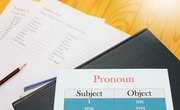Noun cases are the grammatical way that writers show how nouns or pronouns relate to other words in a sentence. Noun cases refer to a noun's function within that sentence. There are three noun cases: subjective, objective and possessive. Each case references a noun's function and place in the sentence as it relates to the other words.
Subjective
Nouns and pronouns appear in the subjective (also known as the nominative) case when they take the form of the sentence's subject or when they are used as predicate nouns. Predicate nouns are preceded by forms of the verb "be" re-identifying the subject in a new way. For example:
"The woman is a waitress."
Here, the word "is" -- a "be" verb -- precedes the word "waitress," which renames "[t]he woman." That means the noun case is subjective.
"The man wants to buy a car."
Here, "[t]he man is the subject of the sentence, and so the case is subjective as well.
Pronouns often used in the subjective case include: “I,” "he," "she," "we," and “they.”
Objective
The objective case is used when a noun or pronoun appears as a direct or indirect object. Direct objects are seen more often in sentences. They follow transitive or action verbs while indirect objects identify the object of the verb's action and also who is the recipient of the direct object. It may also be used when the noun appears as an object of a preposition. For example:
"The girl jumped over the couch."
Here, the couch is the object of the preposition, making the noun case objective.
"The teacher gave us our homework."
Here, the homework is the indirect object.
"The cat ate the cupcakes."
Here, the cupcakes are direct objects.
"Me,” “her," "him," "us," and "them" are pronouns often used in the objective case.
Possessive
Nouns and pronouns in the possessive case show ownership. The placement of the possessive apostrophe matches with the ownership reflected in the possessive noun case. While there are exceptions for spelling, if it is a singular possessive, the apostrophe comes before the "s" while multiple possessives have the apostrophe after the "s". For example:
"Carrie ate Tommy's pancakes."
Tommy is the owner of the pancakes, and so the case is possessive.
"I have lost his favorite shirt."
The pronoun "his" indicates ownership. Other pronouns often used in the possessive case include: "her," "my," "mine," "our," and "their."
Appropriate Usage of Noun Cases
The only noun case that changes form is the possessive case . Keep in mind that pronouns do change form when they change case. Choosing cases base on the position of the noun in the sentence comes into play in sentence situations like linking verbs, "I" v. "me", appositive phrases and cases in captions.
Related Articles
References
Resources
Writer Bio
Ruth Nix began her career teaching a variety of writing classes at the University of Florida. She also worked as a columnist and editorial fellow for "Esquire" magazine. In 2012, Nix was featured in the annual "Best New Poets" anthology and received the Calvin A. VanderWerf Award for excellence in teaching from the University of Florida.











